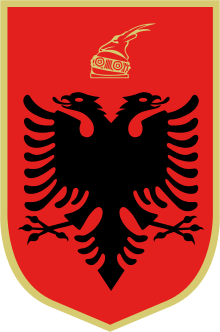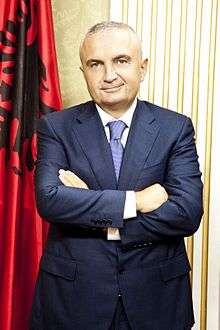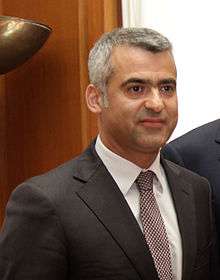Albanian parliamentary election, 2009
| | |||||||||||||||||||||||||||||||||||||||||||||||||||||||||||||||||||||||||||||||||||||||
| |||||||||||||||||||||||||||||||||||||||||||||||||||||||||||||||||||||||||||||||||||||||
| |||||||||||||||||||||||||||||||||||||||||||||||||||||||||||||||||||||||||||||||||||||||
| |||||||||||||||||||||||||||||||||||||||||||||||||||||||||||||||||||||||||||||||||||||||
 |
| This article is part of a series on the politics and government of Albania |
|
|
A parliamentary election was held in Albania on 28 June 2009. No alliance achieved 71 deputies on its own needed to form a parliamentary majority, hence to form the new government the Democratic party and Socialist Movement for Integration joined forces.
Electoral System
The 140 members of Parliament were elected in twelve multi-member constituencies analogous to the country's twelve counties. Within the constituencies, seats are elected by closed list proportional representation, with an electoral threshold of 3% for parties and 5% for alliances.[1]
Seats are allocated to alliances using the d'Hondt system, then to political parties using the Sainte-Laguë method.[2]
Background
Prior to the election, the electoral law was changed to a regional and proportional system.[3][4] Polls from March and April 2009 saw a very close race, with both the governing Democratic Party of Albania and the opposition Socialist Party of Albania around 37%, with minor parties like the Socialist Movement for Integration, the G99 Movement, the Unity for Human Rights Party and the Republican Party of Albania in the low single digits.[5]
Shortly before the election, the ethnic Greek Unity for Human Rights Party switched their allegiance, abandoning their alliance with the Democratic Party of Albania to join the Socialist Party of Albania.[6] The Party for Justice and Integration, a party representing the interest of ethnic Albanians whose properties in Greece were seized after WW2, joined the coalition Alliance of Change.
Alliances
This election saw a total of 33 parties organized in four alliances, one party running on its own and one independent candidate.[7]
- Alliance of Change (Aleance e Ndryshimit), was a center-right coalition made up from 16 parties and led by Prime Minister Sali Berisha.
- Union for Change (Bashkimi për Ndryshim), was a coalition made up from 5 center-left and left winged Parties, led by that-time Mayor of Tirana Edi Rama.
- Socialist Alliance for Integration (Alenaca Socialiste për Integrim), was a coalition made up from 6 center-left and liberal parties, led by former Prime Minister Ilir Meta.
- Pole of Freedom (Poli i Lirisë), was a conservative coalition made up from 6 right winged parties, led by former Prime Minister Aleksander Meksi.
Results
National level
Summary of the 28 June 2009 Assembly of the Republic of Albania election results
| Coalition | Party | Votes | % | Seats | |||
|---|---|---|---|---|---|---|---|
| Alliance for Change | |||||||
| Democratic Party (Partia Demokratike e Shqipërisë) | PD | 610463 | 40.18 | 68 | |||
| Republican Party (Partia Republikane e Shqipërisë) | PR | 31990 | 2.11 | 1 | |||
| Party for Justice and Integration (Partia për Drejtësi dhe Integrim) | PDI | 14477 | 0.95 | 1 | |||
| Environmentalist Agrarian Party (Partia Agrare Ambientaliste) | PAA | 13296 | 0.88 | 0 | |||
| Legality Movement Party (Partia Lëvizja e Legalitetit) | PLL | 10711 | 0.71 | 0 | |||
| Christian Democratic League (Lidhja Demokristiane) | LDK | 6095 | 0.4 | 0 | |||
| National Front Party (Partia Balli Kombëtare) | PBK | 5112 | 0.34 | 0 | |||
| Liberal Democratic Union (Bashkimi Liberal Demokrat) | BLD | 5008 | 0.33 | 0 | |||
| Democratic Alliance Party (Partia Aleanca Demokratike) | AD | 4682 | 0.31 | 0 | |||
| Democratic National Front Party (Partia Balli Kombëtar Demokrat) | PBKD | 4177 | 0.27 | 0 | |||
| Party of New Albanian European democracy (Partia Demokracia e Re Europiane Shqiptare) | PDRESh | 2111 | 0.14 | 0 | |||
| New Party of Denied Rights (Partia e të Drejtave të Mohuara e Re) | PDMR | 1408 | 0.09 | 0 | |||
| Macedonian Alliance for European Integration (Aleanca e Maqedonasve për Integrim Evropian) | AMIE | 1043 | 0.07 | 0 | |||
| Alliance for Democracy and Solidarity (Aleanca për Demokraci dhe Solidaritet) | ADS | 1067 | 0.07 | 0 | |||
| Ora of Albania (Ora e Shqipërisë) | POSh | 786 | 0.05 | 0 | |||
| Forca Albania (Partia Forca Albania) | PFA | 319 | 0.02 | 0 | |||
| Total | 712745 | 46.92 | 70 | ||||
| Unification for Change | |||||||
| Socialist Party (Partia Socialiste e Shqipërisë) | PS | 620586 | 40.85 | 65 | |||
| Social Democratic Party (Partia Socialdemokrate e Shqipërisë) | PSD | 26700 | 1.76 | 0 | |||
| Unity for Human Rights Party (Partia Bashkimi për të Drejtat e Njeriut) | PBDNJ | 18078 | 1.19 | 1 | |||
| G99 (Grupim 99) | G99 | 12989 | 0.86 | 0 | |||
| Social Democracy Party of Albania (Partia Demokracia Sociale e Shqipërisë) | PDS | 10365 | 0.68 | 0 | |||
| Total | 688748 | 45.34 | 66 | ||||
| Socialist Alliance for Integration | |||||||
| Socialist Movement for Integration (Lëvizja Socialiste për Integrim) | LSI | 73678 | 4.85 | 4 | |||
| Real Socialist Party '91 (Partia Socialiste e Vërtetë '91) | PSV '91 | 6548 | 0.43 | 0 | |||
| Movement of Human Rights and Freedoms (Lëvizja për të Drejtat dhe Liritë e Njeriut) | LDLNj | 2931 | 0.19 | 0 | |||
| Green Party (Partia e Gjelbër) | PGj | 437 | 0.03 | 0 | |||
| Party for the Protection of Immigrants' Rights (Parti për Mbrojtjen e të Drejtave të Emigrantëve) | PMDE | 376 | 0.02 | 0 | |||
| New Tolerance Party (Partia Tolerancë e Re e Shqipërisë) | PTR | 437 | 0.03 | 0 | |||
| Total | 84407 | 5.56 | 4 | ||||
| Pole of freedom | |||||||
| Christian Democratic Party (Partia Demokristiane e Shqipërisë) | PDK | 13308 | 0.88 | 0 | |||
| Movement for National Development (Lëvizja për Zhvillim Kombëtar) | LZhK | 10753 | 0.71 | 0 | |||
| Democratic Union Party (Partia Bashkimi Demokrat Shqipëtar) | PBD | 1030 | 0.07 | 0 | |||
| Conservative Party (Partia Konservatore) | PKONS | 1047 | 0.07 | 0 | |||
| Democratic Reform Party (Partia e Reformave Demokratike Shqiptare) | PRDSh | 495 | 0.03 | 0 | |||
| Path of Freedoms Party (Partia Rruga e Lirisë) | PRrL | 1002 | 0.07 | 0 | |||
| Total | 27655 | 1.82 | 0 | ||||
| Law and Justice Party (Partia Ligj dhe Drejtësi) | PLiDr | 4865 | 0.32 | 0 | |||
| Independent | 756 | 0.05 | 0 | ||||
| Total (turnout: 50.77%) | 1,519,176 | 100.00 | 140 | ||||
| Source: CEC | |||||||
Regional Level
The electorate was split in twelve regions, in a regional proportional system, each of which elected a specific number of Members of Parliament (deputet). The following table details the regional results going from North to South.
| Regions | Alliance of Changes | Unification of Changes | Socialist Alliance for Integration | Pole of Freedom | Total seats | ||||
|---|---|---|---|---|---|---|---|---|---|
| % | Seats | % | Seats | % | Seats | % | Seats | ||
| Shkodër | 58.11 | 7 | 35.18 | 4 | 2.9 | 0 | 3.45 | 0 | 11 |
| Kukes | 65.00 | 3 | 31.31 | 1 | 2.97 | 0 | 0.67 | 0 | 4 |
| Lezhe | 54.32 | 4 | 34.47 | 3 | 5.61 | 0 | 3.37 | 0 | 7 |
| Diber | 57.72 | 4 | 32.38 | 2 | 5.72 | 0 | 4.08 | 0 | 6 |
| Durrës | 51.65 | 7 | 39.22 | 5 | 8.02 | 1 | 0.85 | 0 | 13 |
| Tirane | 46.83 | 16 | 45.69 | 15 | 5.24 | 1 | 1.82 | 0 | 32 |
| Elbasan | 45.06 | 7 | 47.77 | 7 | 5.04 | 0 | 1.94 | 0 | 14 |
| Fier | 39.98 | 6 | 51.83 | 9 | 6.47 | 1 | 1.55 | 0 | 16 |
| Berat | 33.16 | 3 | 54.62 | 4 | 11.35 | 1 | 0.68 | 0 | 8 |
| Korce | 46.96 | 6 | 47.82 | 6 | 4.21 | 0 | 0.59 | 0 | 12 |
| Vlore | 37.46 | 5 | 54.89 | 7 | 5.01 | 0 | 2.45 | 0 | 12 |
| Gjirokastër | 40.10 | 2 | 55.9 | 3 | 3.27 | 0 | 0.59 | 0 | 5 |
| Total | 46.92 | 70 | 45.34 | 66 | 5.56 | 4 | 1.82 | 0 | 140 |
Aftermath
Initially the PD led coalition interred into discussions about dividing up the various cabinet posts.[8]
While it was still unclear whether the PD-led alliance held 70 or 71 seats, the leader of the Socialist Movement for Integration (LSI) announced on 4 July 2009 that he had accepted Berisha's invitation to form a government with the PD and stated he wanted to be a stabilising factor in Albania's path towards European Union membership.[9] With the addition of the four seats from LSI, the coalition had the necessary majority to form a government.[9] Nonetheless, in November 2010, the EU in its "Key findings of the Opinion on Albania" found that the political stalemate since the June 2009 elections was a significant barrier to Albania's candidacy for European Union membership.[10]
References
- ↑ Election Profile IFES
- ↑ Electoral system IPU
- ↑ Albania Sets June 28 Election Date, Looks To EU. Javno. January 14, 2009
- ↑ Albania’s Elections and the Challenge of Democratic Transition: June 4, 2009: Briefing of the Commission on Security and Cooperation in Europe
- ↑ Albanian Democrats, Socialists in Close Battle. Angus Reid Global Monitor. May 15, 2009
- ↑ Albania's labor minister resigns as party jumps boat. People's Daily. May 15, 2009
- ↑ Four coalitions to run in Albania's June general elections. Southeast European Times. May 17, 2009
- ↑ "Albania's DP-led coalition starts talks on new government" SETimes.com 21 August 2009, as archived 10 June 2011
- 1 2 Deutsche Presse-Agentur (DPA) (4 July 2009) "Confusion over Albanian polls over, coalition talks begin - Summary" EarthTimes
- ↑ European Commission (9 November 2010) "Key findings of the Opinion on Albania" MEMO/10/553




